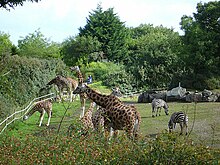
Bristol Zoo was a zoo in the city of Bristol in South West England. The zoo's stated mission was to "maintain and defend" biodiversity through breeding endangered species, conserving threatened species and habitats and promoting a wider understanding of the natural world".
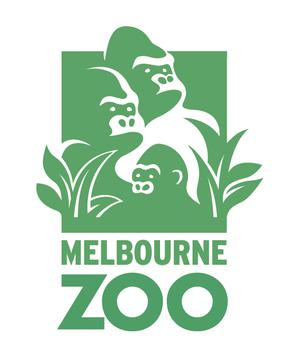
Melbourne Zoo is a zoo in Melbourne, Australia. It is located within Royal Park in Parkville, approximately 4 kilometres (2.5 mi) north of the centre of Melbourne. It is the primary zoo serving Melbourne. As of 2021 the zoo contains 3742 animals comprising 243 species, from Australia and around the world. The zoo is accessible via Royal Park station on the Upfield railway line, and is also accessible via tram routes 58 and 19, as well as by bicycle on the Capital City Trail. Bicycles are not allowed inside the zoo itself.

Apenheul Primate Park is a zoo in Apeldoorn, Netherlands. It specializes in apes and monkeys. It opened in 1971 and was the first zoo in the world where monkeys could walk around freely in the forest and between the visitors. It started with just a few species, now it displays more than 30 different primates, among them bonobo, gorilla and orangutan.

Blackpool Zoo is a 32-acre (13 ha) zoo, owned by Parques Reunidos and located in the sea-side resort of Blackpool, Lancashire, England. It provides a home to over 1,350 animals from all over the world.

Colchester Zoo is a zoological garden situated near Colchester, England. The zoo opened in 1963 and celebrated its 60th anniversary on 2 June 2023. It is home to many rare and endangered species, including big cats, primates and birds as well as many invertebrates and fish species.

Edinburgh Zoo, formerly the Scottish National Zoological Park, is an 82-acre (33 ha) non-profit zoological park in the Corstorphine area of Edinburgh, Scotland.
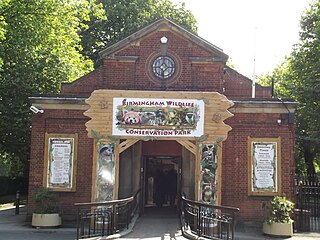
Birmingham Wildlife Conservation Park, formerly Birmingham Nature Centre, and before that Birmingham Zoo, is a small zoo on the edge of Cannon Hill Park in Birmingham, England. It is owned and managed by Birmingham City Council.

Leipzig Zoological Garden, or Leipzig Zoo is a zoo in Leipzig`s district Mitte, Germany. It was first opened on June 9, 1878. It was taken over by the city of Leipzig in 1920 after World War I and now covers about 27 hectares and contains approximately 850 species. By 2020 the zoo featured six different theme worlds, aiming at providing habitats appropriate for the species on display.

Paignton Zoo is a zoo in Paignton, Devon, England. The zoo was started as a private collection by avid animal collector and breeder, Herbert Whitley, in the grounds of his home Primley House. It was opened to the public on a number of occasions, originally as Primley Zoological Gardens, and closed twice due to disputes with the tax authorities. The commercialisation of the zoo came when animals and attractions were relocated from Chessington Zoo during World War II, and the site was named as Devon's Zoo and Circus

Bioparco di Roma is a 17-hectare (42-acre) zoological garden located on part of the original Villa Borghese estate in Rome, Italy. There are 1,114 animals of 222 species maintained.

Woburn Safari Park is a safari park located in Woburn, Bedfordshire, England. Visitors to the park can drive through exhibits, which contain species such as southern white rhino, elephants, tigers and black bears. It is part of the estates of the Duke of Bedford that also includes Woburn Abbey and its 3,000-acre (1,200 ha) deer park. The Safari Park itself covers 360 acres (150 ha).
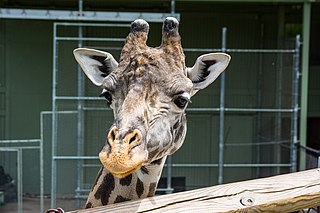
The American Species Survival Plan or SSP program was developed in 1981 by the (American) Association of Zoos and Aquariums to help ensure the survival of selected species in zoos and aquariums, most of which are threatened or endangered in the wild.
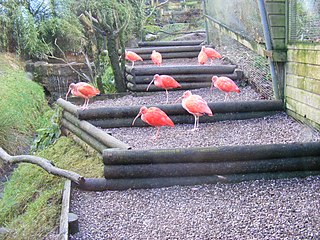
Exmoor Zoo is a conservation centre in Exmoor, North Devon, England. The zoo developed from Exmoor Bird Gardens, opened on the site of a farm in 1982. The current owners took over in 1993, and have enlarged and developed the zoo, now specialising in the conservation of smaller animals. The zoo has been a member of BIAZA, the British and Irish Association of Zoos and Aquariums, since 1995 and recently became a member of EAZA in 2018.

Shanghai Zoological Park, or commonly Shanghai Zoo in short, is the main zoological garden in Shanghai. It is located near the township of Hongqiao and is administratively in Changning District. Shanghai Zoo was formerly known as " Xijiao Park", which is still a common name used locally for the zoo.

Africa Alive! Zoological Reserve, formerly known as Africa Alive! and Suffolk Wildlife Park, is a zoo located in Kessingland, Suffolk, UK. It is situated off the A12 at Kessingland 2 miles (3 km) south of Lowestoft.

Banham Zoological Gardens is a 50-acre (20 ha) zoo in Banham, Norfolk, England. The zoo itself, which today is home to more than 2,000 animals, opened to the public in 1968, became a charity in 2013, and has since been often awarded the prize of Norfolk's Top Attraction, by numerous different organisations, with an annual visitor attendance of in excess of 200,000 people. It is part of the Zoological Society of East Anglia, a registered charity which also owns Africa Alive Zoological Reserve near Lowestoft, Suffolk.

Barcelona Zoo is a zoo in the Parc de la Ciutadella in Barcelona, Catalonia, Spain. The zoo used to be internationally known as the home of Snowflake, the only known albino gorilla, who died in 2003.

The Yorkshire Wildlife Park is an amusement park, wildlife conservation and rehabilition centre and tourist attraction located in Branton, south-east of Doncaster, South Yorkshire, England. It opened in 2009 on the site of Brockholes Farm, a former riding school and petting zoo, and features 500 animals of 100 species. Yorkshire Wildlife Park is an official member of the British and Irish Association of Zoos and Aquariums (BIAZA) and the European Association of Zoos and Aquaria (EAZA).

La Vallée des Singes is a primate park in Romagne, France.

Odense Zoo is a zoological garden in Odense, Denmark.
